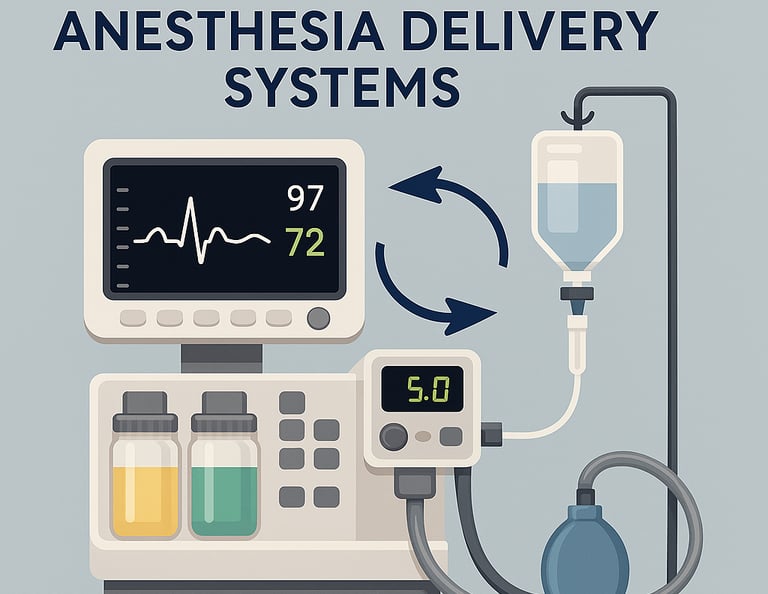The Rise of Closed-Loop Anesthesia Delivery Systems
As precision medicine continues to evolve, anesthesia is embracing a new frontier: closed-loop anesthesia delivery systems (CLADS). These intelligent platforms automate drug administration using real-time feedback from patient monitors, enhancing dosing accuracy, safety, and efficiency in the operating room. This article explores the mechanisms, benefits, challenges, and market landscape of these cutting-edge systems.
medtechoptions.com
4/6/20252 min read


What Is a Closed-Loop Anesthesia Delivery System?
A CLADS is an automated system that adjusts the delivery of anesthetic agents—typically propofol, remifentanil, or volatile agents—based on real-time feedback from physiological parameters like the Bispectral Index (BIS), end-tidal CO2, and hemodynamic data.
The system continuously evaluates the patient's depth of anesthesia.
It modulates drug infusion rates accordingly to maintain a targeted anesthesia level (e.g., BIS between 40–60).
It reduces the need for manual adjustments by the anesthesiologist while maintaining full override control.
Clinical Benefits
Enhanced Patient Safety: Minimizes over- or under-dosing by reacting faster than manual titration.
Reduced Drug Consumption: Studies show 20–30% reductions in anesthetic agent use without compromising sedation depth.
Stable Anesthetic Depth: Improves hemodynamic stability by preventing abrupt shifts in drug levels.
Faster Recovery Times: Tighter control enables smoother emergence from anesthesia.
Citations:
Liu, N., et al. (2020). "Closed-loop coadministration of propofol and remifentanil guided by bispectral index: a randomized multicenter study." Anesthesia & Analgesia, 131(1), 82-92.
Rinehart, J., & Le Manach, Y. (2013). "Closed-loop systems in anesthesia: current status and future directions." Anesthesiology Clinics, 31(1), 125-138.
Key System Components
Drug Delivery Unit: Typically an infusion pump or vaporizer.
Monitoring Interface: BIS, EEG, EtCO2, NIBP, and sometimes hemodynamic monitors.
Control Algorithm: Adjusts infusion rates or vaporizer settings using model-based predictions or adaptive learning.
Leading Manufacturers and Systems
Fresenius Kabi Orchestra® Base Primea with SmartPilot® View: Integrated TCI (target-controlled infusion) with feedback loops.
PhysioDoloris® by Mdoloris Medical Systems: Uses heart rate variability for nociception-guided anesthesia.
Anemon® (Dräger Research Prototypes): A closed-loop volatile anesthesia control system (currently in advanced trials).
Customized academic systems: Developed in collaboration with university hospitals (e.g., Utrecht Medical Center, Stanford Anesthesia).
Cost Considerations
Component Estimated Cost (USD)
Standalone Closed-Loop Workstation $30,000 – $60,000
Smart infusion pumps with CL software $8,000 – $15,000 each
BIS/EEG Monitor Integration $5,000 – $10,000
Full Integrated OR Systems $75,000 – $120,000+
Note: Costs vary based on vendor packages, training, service agreements, and regulatory clearance.
Challenges and Barriers to Adoption
Regulatory Hurdles: Limited FDA-approved systems for full automation.
Trust and Training: Clinicians must be trained and comfortable with automated overrides.
Cost and Infrastructure: Higher upfront investment may be prohibitive in low-resource settings.
Algorithm Validation: Requires diverse population datasets to ensure reliability and safety.
Conclusion
Closed-loop anesthesia delivery represents a pivotal step toward intelligent, responsive, and precision-based perioperative care. With growing clinical evidence and technological advancement, CLADS are poised to become a cornerstone of next-generation anesthesia practice. However, careful integration, clinician education, and thoughtful investment are necessary for widespread adoption.
References
Liu, N., Chazot, T., Genty, A., et al. (2020). "Closed-loop coadministration of propofol and remifentanil guided by bispectral index: a randomized multicenter study." Anesthesia & Analgesia, 131(1), 82-92.
Rinehart, J., Le Manach, Y. (2013). "Closed-loop systems in anesthesia: current status and future directions." Anesthesiology Clinics, 31(1), 125-138.
